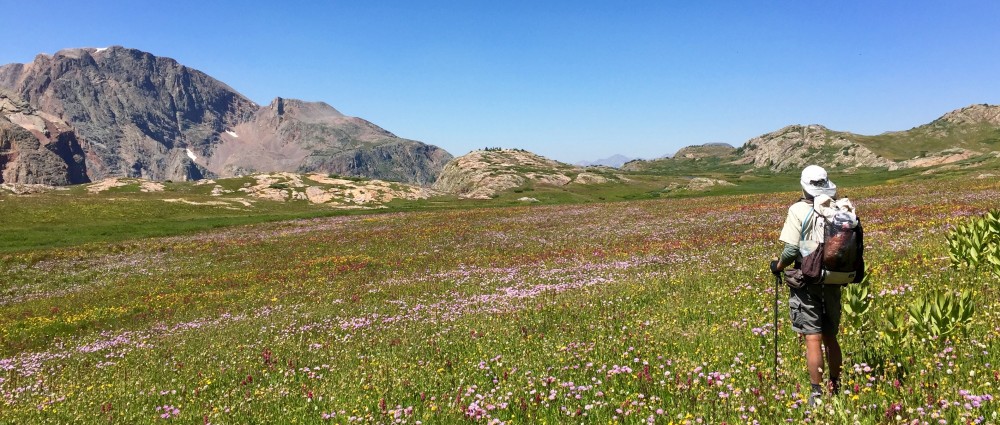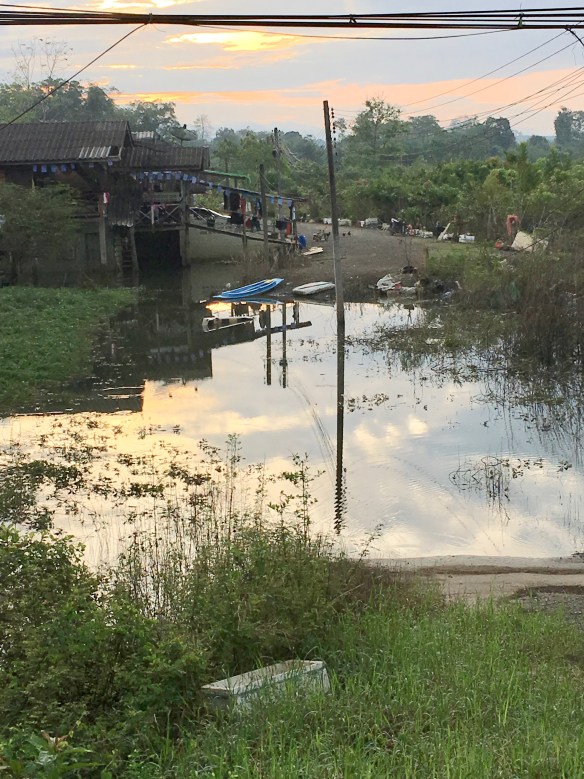One of the favorite tourist attractions in Thailand is a Night Market: an evolution of food stalls for those pre-cooked foods, like pad Thai, soups, meats, fish and sweets, or ingredients for cooking your own meals like noodles, rice, eggs, raw meats and fish, and now combined with clothing, arts and crafts. Heavy emphasis on the clothing and souvenirs.
 The other kind of Thai night market is one that starts about midnight and peaks between 3 AM and 5 AM. One that takes place in that seemingly-abandoned-in-the-daytime open air market with a shambles of rickety tables that mid-morning has only a few tables selling vegetables to housewives.
The other kind of Thai night market is one that starts about midnight and peaks between 3 AM and 5 AM. One that takes place in that seemingly-abandoned-in-the-daytime open air market with a shambles of rickety tables that mid-morning has only a few tables selling vegetables to housewives.

Trang, being the provincial (state) capital, has the regional market that supplies all the mom and pop neighborhood stands as well as other smaller, but lesser. open air markets. It all starts at 2 AM where the wholesale vendors of fish, pork, chicken, a cornucopia of vegetables, pre-packaged meals, drinks and snacks, display their overflowing bounty on those rickety tables. Bundles and bags of goods are quickly shuffled out to triple-parked trucks and three-wheeled scooters, where they’re off to the next stage in the distribution channel.

This market consolidates fish trucked-in in 150-gallon plastic coolers, meat slaughtered the evening before (and butchered on site), pre-plucked chickens (also butchered insitu into all the salable parts), pick-up loads of one type of leafy vegetables {unknown to us) or another (bagged in 5 and 10-kg bundles), heaps of pineapples, bananas, and fruits, plus all the home-made banana-leaf-wrapped snacks of sticky rice with meats or sweets by the hundreds.
 Some foods and snacks are prepared in the stalls, assembly-line style. They are deep frying Thai donuts, other sesame dough-balls with sweets inside, coconut covered treats with fresh coconut meat ground on-site. Still other stalls, countless of them, bag liquid drinks like coffee, coconut milk concoctions, and soups for resale. Green noodle and coconut milk desserts are bagged individually and assembled together for last-minute enjoyment with ice in a bowl at a roadside restaurant or as a home treat.
Some foods and snacks are prepared in the stalls, assembly-line style. They are deep frying Thai donuts, other sesame dough-balls with sweets inside, coconut covered treats with fresh coconut meat ground on-site. Still other stalls, countless of them, bag liquid drinks like coffee, coconut milk concoctions, and soups for resale. Green noodle and coconut milk desserts are bagged individually and assembled together for last-minute enjoyment with ice in a bowl at a roadside restaurant or as a home treat.

Cycling thru the countryside I see scooter-up roadside stands with tables of plastic boxes of pre-packaged foods for breakfasts and lunches. Mom’s or dad’s take their kids (helmet-less) on the back or stuffed in between their legs on the family scooter to school each day, stopping at the neighborhood stand for a school lunch. [Easily 70% of Thai families’ only vehicle is a scooter.] Now I know where these lunches come from. I’d always assumed the family in the house behind had prepared the goods. Maybe they do, but I’ve learned they can be purchased wholesale along with the chicken that gets deep-fried at that same stand each day. Everyone in Thailand has a job.
 We’d asked about the Mu Yang (roast pork) that is famous in Trang, where was it sold? So half-way thru our early morning tour, we rushed off on our scooters to see one of the in-town families that slaughters and roasts their pork each day for sale and consumption. I’d seen the process before in a rural setting, Stanna hadn’t. This operation was an urban business only minutes from the train station.
We’d asked about the Mu Yang (roast pork) that is famous in Trang, where was it sold? So half-way thru our early morning tour, we rushed off on our scooters to see one of the in-town families that slaughters and roasts their pork each day for sale and consumption. I’d seen the process before in a rural setting, Stanna hadn’t. This operation was an urban business only minutes from the train station.
 SunSern let himself in thru a front gate and on to the backyard business of a family that prepares six or more whole pigs for roasting each night. Permission secured (Thai folks always say yes to your viewing how they make or do things), we arrived just in time to see them lower three of their pork carcasses down into the in-ground oven. Wooden staves are burned to charcoal and pushed from a keyhole slot to the bottom of the brick-lined vertical oven.
SunSern let himself in thru a front gate and on to the backyard business of a family that prepares six or more whole pigs for roasting each night. Permission secured (Thai folks always say yes to your viewing how they make or do things), we arrived just in time to see them lower three of their pork carcasses down into the in-ground oven. Wooden staves are burned to charcoal and pushed from a keyhole slot to the bottom of the brick-lined vertical oven.
 The top is then covered with corrugated tin roofing panels and checked for bubbling of the meat that has been coated with the secret family sauce. One hour later, after numerous flashlight inspections and listening for crackling, the roast pork is hauled out and cooled for sectioning and sale at dawn. Trang’s roast pork is the most delicious meat I’ve ever tasted and we got to pick some off the cooling carcasses.
The top is then covered with corrugated tin roofing panels and checked for bubbling of the meat that has been coated with the secret family sauce. One hour later, after numerous flashlight inspections and listening for crackling, the roast pork is hauled out and cooled for sectioning and sale at dawn. Trang’s roast pork is the most delicious meat I’ve ever tasted and we got to pick some off the cooling carcasses.
 Back to the market, by 4 AM the place was hopping with buyers picking up their pre-arranged orders or selecting baskets full of goods for resale at their own stalls or stands.
Back to the market, by 4 AM the place was hopping with buyers picking up their pre-arranged orders or selecting baskets full of goods for resale at their own stalls or stands.


 Southern Thailand is trying to promote destinations other than the underwater weddings, caves, beaches, islands and national parks. Last year I went with a group of cyclists to promote the Seven Dragon Spines of the Andaman Sea (narrow rocky shoals that are only visible off the coast with full moon low tides – seeing all of which will bring a person good luck). Access to these off-shore Dragon Spines is limited to traveling down long mangrove-strewn roads to small fishing villages.
Southern Thailand is trying to promote destinations other than the underwater weddings, caves, beaches, islands and national parks. Last year I went with a group of cyclists to promote the Seven Dragon Spines of the Andaman Sea (narrow rocky shoals that are only visible off the coast with full moon low tides – seeing all of which will bring a person good luck). Access to these off-shore Dragon Spines is limited to traveling down long mangrove-strewn roads to small fishing villages.







 This Wat is distinguished by several features: It’s the headwaters of a natural spring that supplies most of the nearby town, and with it’s proximity to the invasion of European Buddhist foreign visitors seeking a dose of enlightenment and merit making, it uses the English speaking monk to bless them in situ. In return this Wat has received foreign funding for major capital upgrades to the worship hall, baths and toilets.
This Wat is distinguished by several features: It’s the headwaters of a natural spring that supplies most of the nearby town, and with it’s proximity to the invasion of European Buddhist foreign visitors seeking a dose of enlightenment and merit making, it uses the English speaking monk to bless them in situ. In return this Wat has received foreign funding for major capital upgrades to the worship hall, baths and toilets.



















































 Rides start with the obligatory Facebook photo, so that you can show who came that day. Similar to the US, just about all digital communication is done thru Facebook. So if I miss a photo I can be sure to find one on a Thai Facebook site, as you can see with TigerSong’s credited photos.
Rides start with the obligatory Facebook photo, so that you can show who came that day. Similar to the US, just about all digital communication is done thru Facebook. So if I miss a photo I can be sure to find one on a Thai Facebook site, as you can see with TigerSong’s credited photos.






